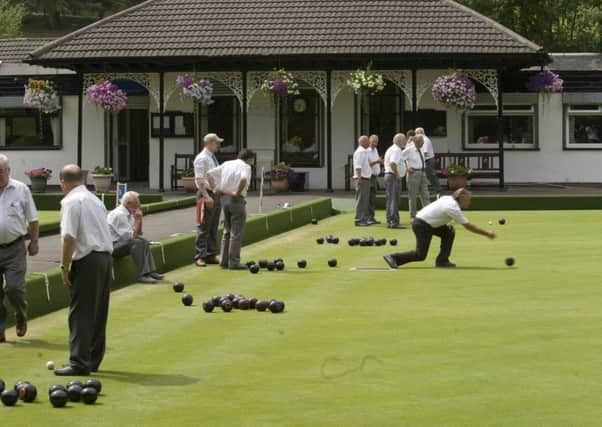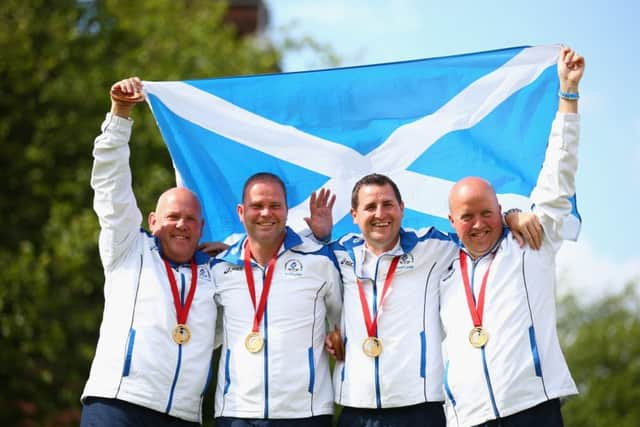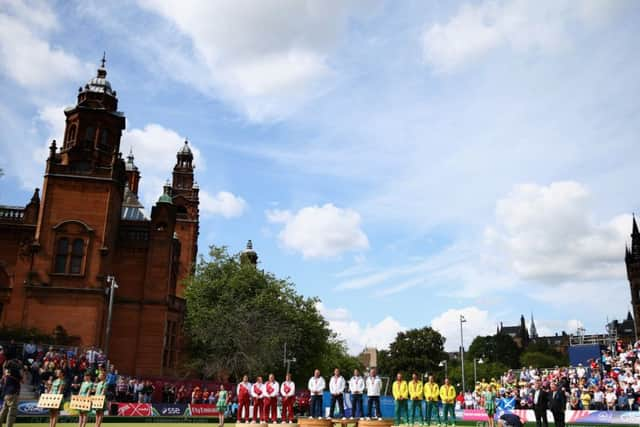How bowls is changing its image in Scotland


When Alex “Tattie” Marshall won two gold medals in the lawn bowling competition in the Commonwealth Games he did more than help set a new national record for Scottish golds and popularise the “get it up ye” salute. The record-breaking six-time World Indoor Singles Champion, who was awarded an MBE in 2007 for his services to the sport, also helped shatter the myth that bowling is the preserve of white-shirted pensioners.
Now, hot on the heels of his victories, comes an attempt in book form to do the same. Hugh Hornby’s Bowled Over shines a light on the game in all its glory from the clubhouses to the people who play and sets the record straight about Scotland’s role in popularising and spreading the game across the world.
Advertisement
Hide AdAdvertisement
Hide AdAlong with debunking some of the historical myths around bowling, the brilliantly illustrated book, packed with tales from the clubs and the history of the game, also takes aim at outdated perceptions of its image.


“In its long history bowls has been stylish, daring – Henry VIII banned it – and there has always been drinking, dining and gambling, and that’s what this generation needs to discover. It’s not a case of people pottering about in whites,” says Hornby.
You will still find whites, afternoon tea and tranquillity in today’s bowls, but there are also men in shorts, women in sundresses, barefoot bowling, glittery balls and wild celebration. You will also find a game where the skill level is always being pushed onwards and upwards.
“Today the game is more aggressive,” says Hornby. “The power of the striking is almost getting dangerous so you’re not really comfortable standing behind it in case it whisks off the wood. That makes it more exciting. It’s pretty full on.”
Why does Hornby think the British have such a love affair with bowling?


“We have the right climate for it for a start. We are good at growing grass and gardening. People get very obsessive about lawns; you don’t find that in other countries. Also, we are very good at inventing sports and games and are always on the lookout to improve them,” he says.
“And it’s very clear from the examples we have come across that, for the early clubs, bowling was only a small part of the day out. It was a way of making friends, having a short game and a small bet, then going for a meal at an attached inn. More time was spent eating and passing the port than on the bowling green. And for many today, the bowling club is their local pub.”
Hornby has spent years travelling the length and breadth of Britain, visiting more than 500 bowling greens up and down the country, from village greens to country houses, pubs and breweries with club houses ranging from fine pavilions to gothic castellated creations. Among the ones that star in the book is the Pavilion at Ardgowan Bowling Club in Greenock, an arts and crafts delight dating from 1926, and one of 16 listed pavilions still used for bowls. One of the grandest bowling pavilions is the Grade I listed Bowling Green House at Swarkestone in Derbyshire, that also featured on the back cover of the Rolling Stones’ 1971 Hot Rocks album.
Advertisement
Hide AdAdvertisement
Hide Ad“One of the grounds I really liked was Garlieston in Galloway,” says Hornby. “There the green is split into two halves because it’s on a strip on the waterfront where a square was impossible. Also, one feature of Scottish bowling and Scottish architecture is greens in hidden patches where you couldn’t imagine anything being built on it. Hillside Bowling Club in Edinburgh for instance,” he says, of the club which is accessed down a flight of steps between tenements and where the green sits plumb in the middle of the back gardens.
Even if you’ve never set foot on a bowling green yourself, chances are you could name several off the top of your head, dotted around your neighbourhood, and that’s because bowling is hugely popular. Always has been. Older than football, cricket and golf in terms of being codified, it may not have a massive numbers of spectators but bowls is the sport we’re all playing at more than 7,400 clubs the length and breadth of Britain.
While the Scots have been credited with the development and spread of flat green bowling, tracking down the inventors of the game is not so easy.
“In the past historians have said it dates to the 13th century, thanks to the Victorian obsession of tracing a romantic ideal that it went back to the Crusades. In practice there isn’t really any evidence for the modern game until the 16th century.”
This might not be what the clubs want to hear, but Hornby has a historian’s zeal for the truth
“We have ended up with a much stronger sense of a game that evolves through the Middle Ages,” he says. “Lawns in the 16th century would be used for bowls, and there is evidence from court records, Shakespeare’s plays and maps.” James IV is recorded in 1496 as losing bets on two forms of bowls played at Holyrood and Stirling, “lang bowlis” and “row bowlis”, and by the time James VI ascended the Scottish throne in 1567 the British were bowling in ways that would be immediately recognisable to modern bowlers. In Scotland there were clubs in Haddington, Kilmarnock and Lanark as far back as the 18th century.
“Leith crops up in references through the last few hundred years,” says Hornby. “There are recreational spaces on well drained, open, flat ground and it is reasonable to suggest that the game was developing in parallel in England and Scotland.”
It was Scotland however, that er, picked up and ran with the ball, when it came to bowling, and according to Hornby it is no exaggeration to say that the Scots more or less invented the modern, flat green form of the game with the levelling and laying out of flat rinks.
Advertisement
Hide AdAdvertisement
Hide Ad“The Scots are responsible for the development of bowling. Level greens made in the 19th century onwards were about improvements and progression,” says Hornby. “There’s also the influence of curling to consider, which was attracting huge crowds and wanting to organise too.”
So bowling developed into flat green, where the greens are level, particularly in Scotland, and crown green, mainly in England where the greens were more irregular. In England, legendary cricketer WG Grace actively campaigned for the spread of flat green bowling, but this wasn’t without controversy. Many an English club dinner ended in rancour at the prospect of flattening the greens, and the Edinburgh Evening News gleefully reported on “The Crisis in English Bowling”.
Also key to the development of the game was Glaswegian William Wallace Mitchell, aka “Mr Bowls”, who developed a set of rules in 1864 that were adopted by the Scottish Bowling Association and ultimately across the world. The Mitchell rules were born of a desire to get organised, get more players on a green at once and play against other clubs.
It was also in Glasgow that Thomas Taylor perfected the art of creating matched sets of woods in the 1870s, which became all the rage. Even today Glasgow has the highest concentration of bowling greens and clubs in the country. The six greens at Kelvingrove, where 35,000 spectators watched the bowling over nine days in 2014 and saw the Scots win three golds overall, constitute the single largest concentration of public bowling greens in Britain.
“The Scots embraced the Mitchell rules long before anyone in England and because there were so many Scots travelling around the world to the US, New Zealand and Australia, the modern flat green game became established before it had a foothold in England. When international games began to be talked about it was clearly the flat green game that was being played.
“Each has its own complexity and tactics,” says Hornby, who is a crown green bowler himself, and started playing as a youth in his home village of St Michael’s On Wyre, Lancashire.
“When I was 14, I played with a couple of friends in the club then went home and mentioned it to my granny. She told me my grandfather played and there was a set of wooden bowls in the garage. So I started playing with them.”
Now 46, Hornby is the captain and secretary of his club, the St Michael’s Bowling Club, secretary of the North Lancashire & Fylde County Bowling Association and plays for Lancashire. Does he think bowling is increasing in popularity? “Well, there’s a lack of TV coverage compared with the 1980s and 1990s but the Commonwealth Games certainly helped. The Scots are very successful at the moment and that helps too. There are a lot of young players in both flat green and crown green.”
Advertisement
Hide AdAdvertisement
Hide AdIndeed, the winner of the perhaps unfortunately named 2015 Co-operative Funeralcare Waterloo Crown Green Bowling Tournament at Blackpool was 22-year-old Greg Smith, who made history by being the joint youngest winner of the centuries-old event. Smith has been playing since he was five years old.
“That game was on ITV,” says Hornby, “the first terrestrial TV coverage for a long time. The game has an image of old people playing and it’s great that life expectancy is growing and they are playing, but there’s such a long gap between teenagers and 80-year-olds that they need to bridge that. They’ve got great facilities, good locations and the challenge is to attract people in their thirties and forties who have stopped playing rugby and football. The main thing it needs at the moment is exposure.”
Hornby points out that bowling greens were originally flexible recreational spaces, used for flower shows, dances and other games before the bowlers wrested control and closed them off.
Barefoot bowling is one initiative that might attract newcomers, having been exported from Australia in the last decade. It is much beloved of office workers in London who have taken to rolling a few balls around Hyde Park in bare feet, bottle in hand. It’s also popular at Kelvingrove, where since 2014 the greens have been available to the public seven days a week for no charge and initiatives include “bowls and blethers”, “blokes who bowl” and barefoot bowls.
Also more relaxed is the dress code, with whites and box skirts and hats for the ladies a thing of the past. Today it’s all sportswear, Lycra and leisurewear.
“These days bowlers wear colour and it’s more attractive, in line with other sports. Crown green bowling has always had a notoriously relaxed dress code anyway. The club I play at has no dress code at all. People come straight from work. Joiners, plumbers…” Historians.
Hornby is optimistic about the future of his beloved sport and hopes to see it thrive and flourish, confident that the game can attract new generations of players. “Because the game is addictive, the only hurdle is to get people to have a go. Once they do it, they’re hooked.”
• Bowled Over, one of the Played In Britain Series, by Hugh Hornby, published by Historic England, is available from Saturday in softback, £17.99